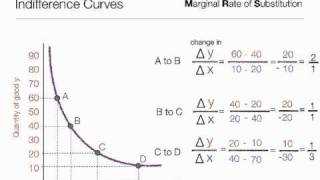MRS in Economics: Calculation Formula and Explanation
In economics, the Marginal Rate of Substitution (MRS) is a concept that measures the rate at which a consumer is willing to trade one good for another while maintaining the same level of satisfaction. It is an important concept in microeconomics as it helps to understand consumer preferences and decision-making.
The calculation formula for MRS is as follows:
MRS = ΔY / ΔX
Where ΔY represents the change in the quantity of one good and ΔX represents the change in the quantity of another good. The MRS indicates the amount of one good a consumer is willing to give up to obtain an additional unit of another good while remaining equally satisfied.
The Marginal Rate of Substitution (MRS) is a concept in economics that measures the rate at which a consumer is willing to trade one good for another while maintaining the same level of satisfaction. It helps economists analyze consumer behavior and understand how individuals make choices based on their preferences and constraints.
The MRS is calculated by taking the ratio of the marginal utility of one good to the marginal utility of another good. Marginal utility refers to the additional satisfaction or utility a consumer derives from consuming an additional unit of a good. By comparing the marginal utilities of different goods, economists can determine how much of one good a consumer is willing to give up to obtain more of another good.
For example, let’s say a consumer is considering whether to buy apples or oranges. The consumer’s marginal utility from the first apple is 10 utils, while the marginal utility from the first orange is 8 utils. The MRS would be calculated as 10/8, which equals 1.25. This means that the consumer is willing to give up 1.25 oranges to obtain an additional apple while maintaining the same level of satisfaction.
The MRS can vary depending on the preferences and constraints of the consumer. If the consumer has a strong preference for apples, the MRS may be higher, indicating a greater willingness to trade oranges for apples. On the other hand, if the consumer has a limited budget or faces other constraints, the MRS may be lower, indicating a lower willingness to trade one good for another.
Calculating the Marginal Rate of Substitution

To calculate the Marginal Rate of Substitution, you need to know the quantities of the two goods being considered and the level of satisfaction or utility derived from consuming those goods. Let’s consider an example:
Suppose a consumer has 10 units of good X and 5 units of good Y. The consumer’s utility function, which represents the level of satisfaction derived from consuming the goods, is given by U(X, Y) = X^0.5 * Y^0.5.
dU/dX = 0.5 * (X^(-0.5)) * (Y^0.5)
dU/dY = 0.5 * (X^0.5) * (Y^(-0.5))
Next, we divide the partial derivative of X by the partial derivative of Y:
MRS = (dU/dX) / (dU/dY) = (0.5 * (X^(-0.5)) * (Y^0.5)) / (0.5 * (X^0.5) * (Y^(-0.5)))
Simplifying the equation, we get:
MRS = (Y/X)
In our example, the consumer has 10 units of X and 5 units of Y, so the Marginal Rate of Substitution is:
MRS = (5/10) = 0.5
This means that the consumer is willing to give up 0.5 units of Y to obtain an additional unit of X while keeping the same level of satisfaction.
Interpreting the Marginal Rate of Substitution

The Marginal Rate of Substitution (MRS) is a concept in microeconomics that measures the rate at which a consumer is willing to trade one good for another while maintaining the same level of satisfaction. It represents the amount of one good a consumer is willing to give up in order to obtain an additional unit of another good.
To interpret the MRS, we need to understand the concept of diminishing marginal utility. Diminishing marginal utility states that as a consumer consumes more of a particular good, the additional satisfaction or utility derived from each additional unit of the good decreases.
The interpretation of the MRS depends on its value. If the MRS is constant, it means that the consumer is willing to trade goods at a fixed rate. For example, if the MRS is 2:1, it means that the consumer is always willing to give up 2 units of good X to obtain 1 additional unit of good Y.
Implications of the MRS

The MRS has important implications for consumer behavior and decision-making. It helps economists understand how consumers allocate their resources and make choices based on their preferences and constraints.
By analyzing the MRS, economists can determine the optimal consumption bundle for a consumer. The optimal consumption bundle is the combination of goods that maximizes the consumer’s satisfaction or utility, given their budget constraint. The MRS helps identify the trade-offs a consumer is willing to make between goods to achieve the highest level of satisfaction.
Furthermore, the MRS can also be used to analyze the substitution effect and income effect. The substitution effect refers to the change in consumption of one good in response to a change in its relative price, while keeping utility constant. The income effect refers to the change in consumption of one good in response to a change in income, while keeping prices constant. The MRS helps quantify these effects and understand how they influence consumer behavior.
Application of the Marginal Rate of Substitution in Microeconomics
One of the key applications of the MRS is in analyzing consumer choices and optimizing utility. By calculating the MRS, economists can determine the optimal combination of goods that maximizes a consumer’s satisfaction or utility.
To illustrate this, let’s consider a simple example. Suppose a consumer has a fixed budget and can purchase only two goods: apples and oranges. The consumer’s goal is to maximize their satisfaction or utility. The MRS measures how many apples the consumer is willing to give up to obtain an additional orange while keeping the same level of satisfaction.
For instance, if the MRS is 2, it means the consumer is willing to give up 2 apples to obtain 1 additional orange and still be equally satisfied. If the MRS is 1/2, it means the consumer is willing to give up 1/2 an orange to obtain 1 additional apple and maintain the same level of satisfaction.
The MRS can also provide insights into consumer preferences and the substitution effect. If the MRS is constant, it implies that the consumer has constant preferences and is willing to trade goods at a fixed rate. On the other hand, if the MRS varies, it suggests that the consumer’s preferences are changing, and they are willing to trade goods at different rates.
In summary, the Marginal Rate of Substitution is a crucial concept in microeconomics that helps economists understand consumer preferences, optimize utility, and analyze demand. By calculating the MRS, economists can make predictions about consumer behavior and make informed decisions regarding resource allocation and pricing strategies.

Emily Bibb simplifies finance through bestselling books and articles, bridging complex concepts for everyday understanding. Engaging audiences via social media, she shares insights for financial success. Active in seminars and philanthropy, Bibb aims to create a more financially informed society, driven by her passion for empowering others.
